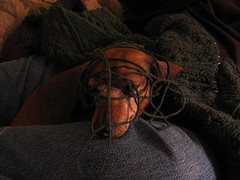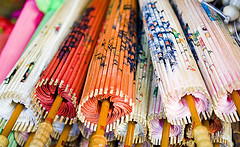Looking after the readers
Reader service isn't my primary function, but the whole point of having a library is so that readers can use it, so that's where I'll start this overview. Our library has a Rare Books Reading Room that could, technically, seat up to 60 people, although they'd be frightfully squashed. And average day would generally see up to 20 readers in at one time. The 'Rare Books' net is cast fairly wide: it covers all printed material produced pre-1900, and selected printed material produced post-1900. Manuscripts are produced in a separate room. The department has a team of book fetchers (who fetch around 1,000 items a week) and room supervisors who manage the day-to-day production of material and supervision of the room. I do occasional stints on the reading room desk to cover lunchtimes, break times, evenings, Saturdays and absences for sickness or holiday. I'm also one of the people asked to help out with non-standard enquiries. This week a couple of people were on holiday, so my share of desk duty was higher than normal. Summer is also a busy time for the room, as lots of scholars make trips to research libraries at this time of year, making the most of a break from teaching responsibilities to get on with their own research. Visiting researchers often want to see a lot of books in a fairly short time, they're less familiar with our policies, practices and services than our regulars, and as they're likely to be off to the next library very soon, they'll want their photocopying done as quickly as possible! |
| To be fair, our till doesn't look like this at all. |
Looking after the books
We're very fortunate to have a certain budget in the department for new acquisitions of rare material. We generally purchase in order to supplement existing collection strengths, rather than to try and be 'completist' about our holdings. As I've only been in post for a few months, I'm still getting to know the collections (have a look at our collection summaries here and you'll start to understand why!), so I don't have much of a role in choosing new purchases. But I do do some of the background checking before we buy: double checking catalogues (both electronic and paper) to see if we, or other Cambridge libraries, already hold a copy, for example.Once we've decided to get a book, it has to be checked on arrival to make sure we've got what we were expecting - all pages and plates are counted and checked, the condition is examined, etc. etc. And then it goes onto the cataloguing shelf.
I love cataloguing rare books, but it's fair to say that there's a knack to doing it efficiently that I haven't yet grasped. One can go to almost infinite lengths checking previous owners (we record as a matter of course any kinds of provenance marks in or on the books), deciding on binding materials and dates, and looking up references to the book in question.
Here are a couple of recent examples: a bibliography of the works of a geologist, acquired with a collection of his papers (this book was transferred to us from the manuscripts department) and a book of seventeenth-century German concrete poetry, lavishly embellished with extra plates relating to the city of Nuremberg by an early owner.
Exhibitions
I'm very fortunate that I'm responsible for the Library's internal exhibition cases, located on our main corridor on the way to the Tea Room. The exhibition programme sees a new display every two to three months. These are curated generally by members of Library staff, and cover a range of topics which enable us to showcase holdings or themes that wouldn't necessarily be included in the main public exhibition area. Recent topics have been Ernest Hemingway, and twentieth-century Dutch book bindings. The next exhibition will be set out this week; I've been advising the curators throughout about suitability of material for display, case sizes, caption conventions, and so on.Project work
Our department currently has a major cataloguing project in train. The Incunabula Project, funded by the Andrew W. Mellon Foundation, will see the Library's holdings of pre-1501 books (known as 'incunabula'), which number over 4,500, catalogued to the fullest current standards. The cataloguing work falls mainly to the project's Research Associate and others of my colleagues, but I am working to support the project by producing on online guide to the history of the incunable collection. With the permission of the publishers, CUP, we are producing a web version of the introduction to the collection written by J.C.T. Oates, the author of the 1950s short-title catalogue of the collection (the only catalogue currently available). Oates' introduction is a masterful example of academic librarianly writing of its period, but to modern eyes it's somewhat wordy. I'm doing what I can to make it useful to the modern reader by dividing it into meaningful sections, and illustrating as many of these as possible with images of our books.These images will focus particularly, where possible, on marks of provenance and other copy-specific details, so I am taking a lot of images myself specifically for this project. This past week I've done a lot of work taking images to slot into the webpages that I have already pretty much finished writing. Soon I hope to be able to hand the whole lot over to colleagues for proofreading.
Misc.
From time-to-time I'm obviously also involved in other things, such as supervising TV film crews who wish to use our materials, or helping with Library open days for prospective students or University Alumni. The nature of the holdings in our department means, however that even a 'standard' day usually holds lots of interest.On the back of similar posts in the past I've had a few emails from new professionals interested in special collections work. I'm always happy to answer any questions you might have, either in the comments here, or in email, but I'm fairly new to this myself and certainly don't proclaim myself any sort of expert!










